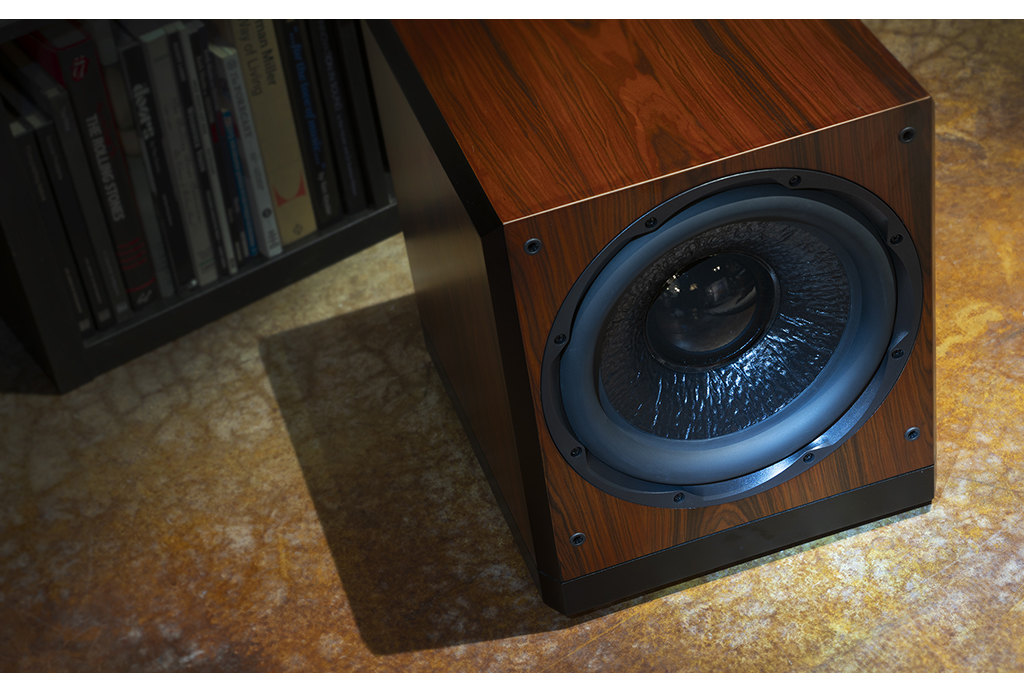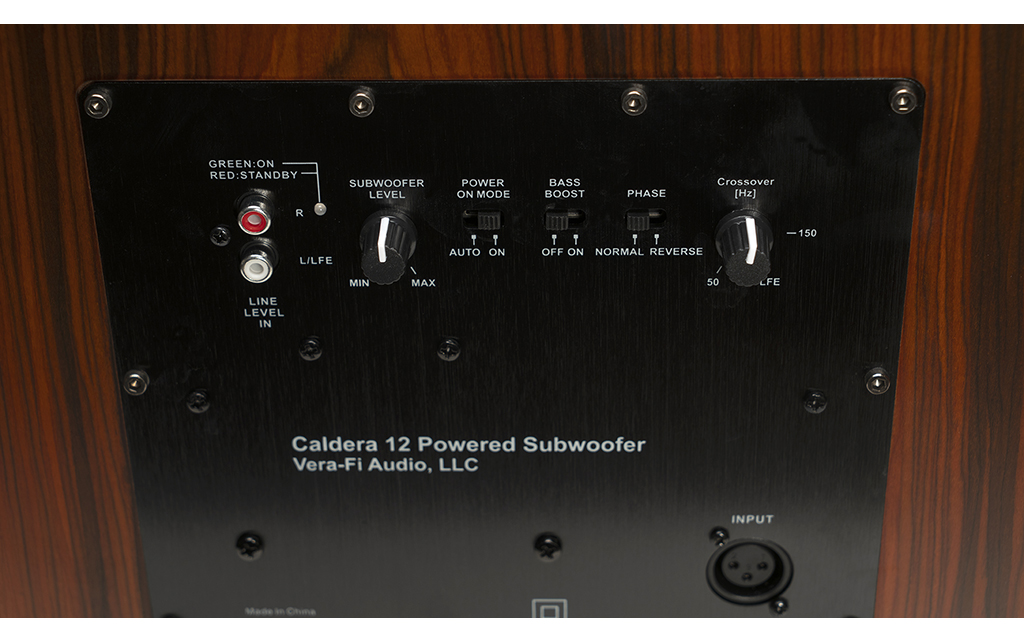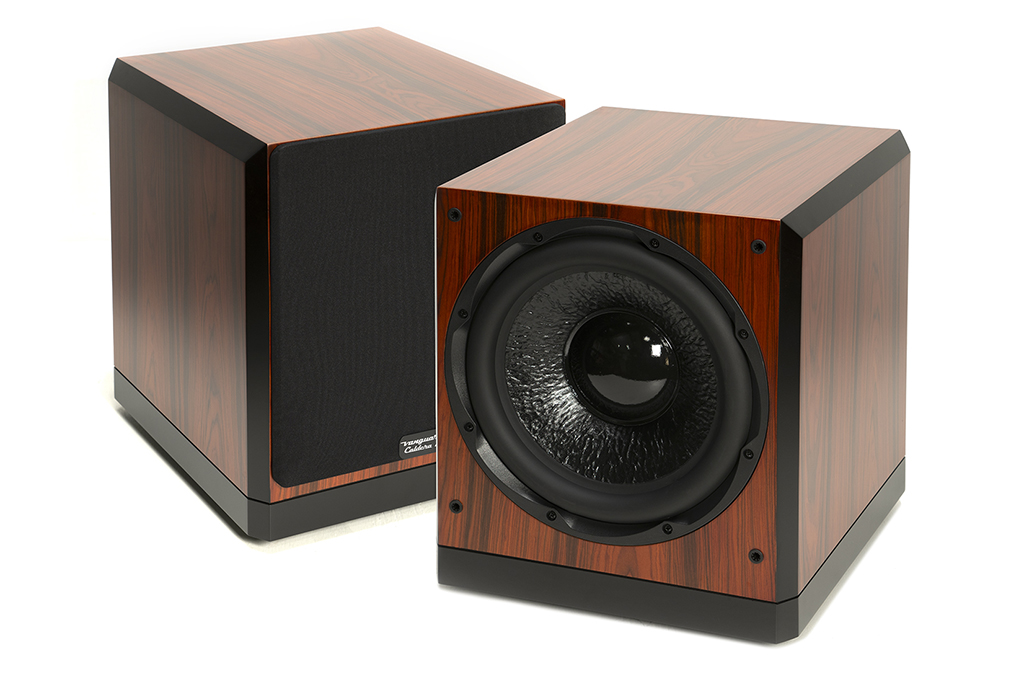The Vera-Fi Caldera 12 Subwoofer The essentials, served up splendidly
By Jeff Dorgay
Digging right in with the Caldera 12 and driving it down the rough road with a long playlist of Stanley Clark, Jaco Pastorius, and Tool tracks (but not “Chocolate Chip Trip,” because that is becoming the metal version of “Keith Don’t Go”) reveals it has what it takes to get the job done.
Veri-Fi principal Mark Schifter has been in this industry for a long time, and he’s always had a handle on what’s really important. The casework on the Caldera 12 is nice but not elaborate (i.e., overly expensive). Functionality is simple, functional, and practical. There are no microprocessor controls, apps, or DSP. Packaging is simple but effective, and it only comes in one color, a tasteful rosewood veneer with black edgework.
The Caldera 12 demands that you take a little time to fiddle with the level controls and the crossover setting manually. The extra effort rewards you with much better audio performance than is usually possible at this price. The fact that all Vera-fi products are manufacturer-direct strips another level of margin from the MSRP.
This isn’t mind-blowing, game-changing, destroying of other things costing ten times as much. It’s math. Fewer people in the chain and on the payroll means savings to the consumer. It’s kind of like a golf handicap. So, to level the playing field, you’d have to compare the Caldera 12 to something from KEF, B & W, or the like in the $1,000 (or a bit more) range to make it fair. In that context, based on sonics, the Caldera more than delivers the goods.
Setup
At 20 x 20 x 20 inches and weighing in at 44 pounds, you may or may not need help moving your Caldera 12 around. The 12-inch driver utilizes a treated paper cone with a rubber surround, and VF claims a -3dB point of 22 Hz. The Caldera 12 is a slotted design, so you have a few more placement options than a ported sub. A 500-watt class-D amplifier keeps the bass rumbling, and in my listening tests, I could not bottom out the driver. Even with the opening heartbeat in Pink Floyd’s “Dark Side of The Moon.” Running a series of test tones with the Caldera in my living room (in corner placement) confirms that 20 Hz tones are reproduced with authority.

As my living room is 13 x 18 feet, but it “sees” the adjoining kitchen, dining room, and hallway to the back of the house, it’s easy to integrate this sub with a number of the main speakers that I tried it with. Much fun as it was with a handful of mini-monitors from Vera-Fi, SVS, Dynaudio, and YG – it was more than fun (what is that?) with a pair of vintage Acoustat 1+1 ESL speakers. I wish I had this sub in the 80s when I had these speakers the first time.
Placement and fine-tuning
The Caldera 12 has the standard controls for level, crossover frequency, and normal/reverse phase. A pair of RCA jacks is available for line-level connection. If you are using this in a theater system, the left channel can be used for LFE. When doing so, the crossover frequency control must also be set to the LFE position.
There is also a control for bass boost, which might be too much for most of you. However, if you have to place your sub in the middle of the room or a huge room and you just aren’t feeling it, this offers a gentle nudge in the lowest frequencies. As I did not use the Caldera 12 in a theater arrangement, this also may deliver a bit of that exaggerated bass response that movie people seem to love.
Using the Caldera 12 in the corner of the room, allowing the sub to see the longest amount of floor, proved best. With the mini-monitors, the crossover tended to land in the 50-70 Hz range, and with the panels, all the way down to 50. The only complaint about the Caldera 12 is it would be handy and easier to mate this sub with a broader range of speakers if that crossover control went down to 35 or 40 Hz. With a pair of these, you could easily mate them up with something larger.
Should you have to do a center placement with a single Caldera 12, try to situate it somewhat off-center, or you may get a bass bump somewhere between 40 and 70 Hz. Again, break out those test tones and check for integration.
Nearly all the complaints I’ve heard over the years with subwoofers not mating properly with the main speakers is a result of crossing them over too high. Start with the crossover frequency all the way down at 50, and work your way up slowly. Experience has shown a lower crossover frequency setting, and a bit higher output goes a long way in seamlessly mating the sub to the mains. Find a way to get some test tones, and check this out for yourself. Running tones at 20 to about 100 Hz in 10 Hz increments, you can fine-tune the smoothness between sub and mains so there are no anomalies. More often than not, it’s the setup, not the sub.
More listening
Out in the main listening room, which is 24 x 36 feet, a pair of Caldera 12s would make a fantastic addition to my JBL Classic 100s, the Wharfedale Super Lintons, and the Wharfedale Dovedales. Room corner placement is the rule again, but in the larger room, with a pair, I was able to move them out a few more inches than the tight quarters in my living room allow.
A wide range of music, from heavy rock to hip hop, reveals that the Caldera 12 has no problems “keeping up with the mains,” and low-frequency notes have great speed and definition. These are definitely not one-note bass subwoofers.
When everything is correctly set up, you will notice more depth and definition in your system’s presentation. Shutting the sub off should shrink the size of your soundstage, even when playing material that is not bass-heavy – that’s the ultimate test of your setup skills.

An excellent value
Thanks to the reasons mentioned at the beginning of this review, the Caldera 12 is a solidly designed, well-performing sub. It’s an honest product, delivering financial and sonic value well above the asking price. #toneaudioapproved, and a worthy Exceptional Value Award winner.
If you are a music lover seeking to reproduce that lower register in a way that your main speakers just can’t, the Caldera 12 subs will make a fantastic addition to your system and musical enjoyment. Once you have them (and I suggest a pair, if you can), you’ll never go back to not having a great subwoofer in your system.
$399 ea (for now, because…)
www.verafiaudiollc.com



